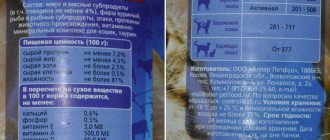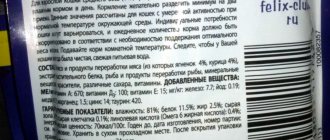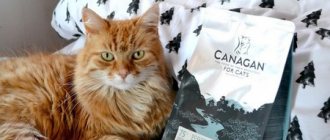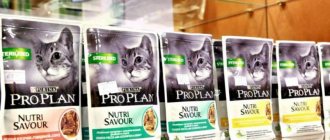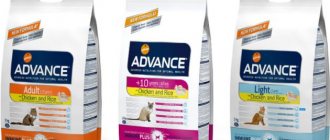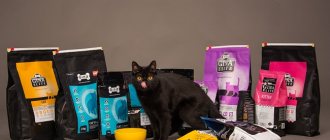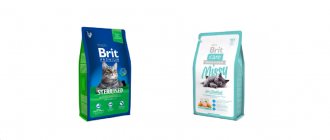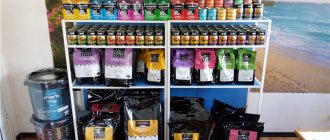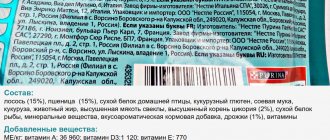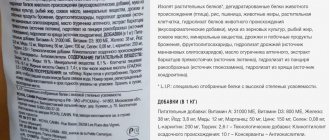Cat Chow is one of the cat food lines from Purina. According to the manufacturer, it is developed by experts in the field of veterinary medicine and nutrition to create balanced diets taking into account the characteristics of the body of cats. The range includes products for animals of different ages, including those with specific health needs. An analysis of the product’s composition, reviews from veterinarians and animal owners who have already purchased food for their cats will help determine how suitable this food is for your pet.
Product range
Purina Cat Chow's assortment includes dry and wet diets, which is especially convenient given the recommendations to select food for pets in different forms within the same brand.
Dry food
Dry Cat Chow granules are available in soft packs of 400 g, 1.5 kg and 15 kg. The manufacturer offers a variety of options taking into account the age and health characteristics of cats:
- Kitten – for kittens (from 6 weeks to 1 year), pregnant and lactating individuals.
- Adult – for adult animals (with duck or poultry).
- Sterilized – for spayed/neutered adult animals (poultry or poultry and salmon) with an optimal balance of protein and fat to compensate for the effects of hormonal changes in the animal's body.
- Sensitive – for adult pets with sensitive digestion.
- Hairball Control - with additional sources of fiber that stimulate the removal of hair from the stomach.
- Urinary Tract Health – with minimal levels of magnesium and added fish oil to support urinary tract health.
- Feline – triple protection with a special formula for healthy teeth and urinary system, as well as preventing the accumulation of hair in the stomach.
Each food includes Naturium Complex, a formula with fiber from natural sources and prebiotics to support a healthy cat's digestive system.
Wet food
The range of wet diets at Cat Chow is not as rich as compared to dry diets. They are produced in 85 g bags, taking into account the age characteristics of the animals:
- For kittens (with turkey).
- For individuals over 1 year old (4 flavor options).
Composition analysis
Despite the fact that Cat Chow's assortment includes cat food with different flavors, their composition is almost identical, with the exception of the percentage of plant components or the presence of other additives. In this case, the quality can be assessed by the components indicated in the first five composition. As an example, let's look at what components are listed on these positions for Cat Chow Sensitive food:
- cereals (whole grain);
- meat and processed meat products (20%, which is equivalent to 40% rehydrated meat and processed products, at least 14% poultry);
- vegetable protein extracts;
- vegetable and animal fats;
- fish and fish by-products (2%, equivalent to 4% of rehydrated fish and by-products, not less than 4% of salmon).
Next in the composition is a number of additives of plant materials, vegetables, mineral components, yeast, preservatives and vitamins. The manufacturer marks natural ingredients on the packaging with a “*” sign. But there is no such marking for preservatives and antioxidants, which suggests the use of synthetic raw materials.
Thus, the basis of Cat Chow food is cereals, since they “lead” the composition, and vegetable proteins. The bulk of the components do not have precise descriptions or indications of the raw materials used. Even for the very first of them - cereals - it is not indicated which crop the manufacturer uses. The situation is similar with sources of fats, meat and fish components, for which there is no data other than the minimum percentage of the latter. Vegetable protein extract is another component obtained from unknown plant materials, which, due to its origin, is not of particular value to the cat’s body. Sources of fiber are vegetable supplements, but here too the manufacturer saves by using primarily not whole vegetables, but their processed products.
In general, the amount of protein, fat, and fiber is within acceptable limits, but due to the minimal presence of natural meat and the dubious origin of most components, the nutritional value of the product is low, and accordingly, the consumption for satiating the cat will be increased.
Review of Cat Chow cat food
Dry food for cats Cat Chow (Cat Chow) belongs to the economy class.
It is produced by Purina (Nestle Purina PetCare Company, USA) in Russia (RU marking) and Hungary (HU marking). The official Russian website for food is , it contains information about the composition of the food, feeding recommendations, and also a lot of text about how good this food is. We will check this information below, and here we will also note that Purina also produces food from other brands for cats and dogs. For example, Darling, ProPlan (premium class), One, Dog Chow, Friskies, Gourmet, Felix.
Cat Chow food composition
Let's study the composition of Cat Chow dry food using the example of the Kitten variant (“for kittens, with a high chicken content”). First, see its composition for yourself, to do this, click on the image below to enlarge it (for easier reading):
On the left is a photo of the composition indicated on the packaging, on the right is a screen shot from the official website.
As in most economy-class food, the first ingredient here is cereals. It is specified that this is a whole grain, but what crops are not specified (wheat, barley, oats?). Cereals are mainly a source of carbohydrates. It is not indicated what their percentage in the composition is.
In second place are meat and meat products. It’s good that the quantity is specified - 33%, but the bad thing is that it is not specified how much meat and by-products there are. In addition, it is not specified what exactly these meat products are.
Dry beet pulp is a source of fiber, dry parsley is more of a seasoning than a truly healthy ingredient. It should be noted that these ingredients are not used here, but their processed products! They even saved on beet pulp...
Vegetable protein extract is a source of plant proteins, vegetable and animal fats are sources of fatty acids, vegetables are sources of vitamins. And if the latter are clarified, then what crops the protein and oils are obtained from, as well as what animal fats are not specified.
The composition is completed by a set of additives: minerals, preservatives, yeast, vitamins, antioxidants. Again, it is not specified what preservatives and antioxidants are used.
Advantages and disadvantages
Among the advantages of this food:
- the percentage of meat ingredients in the composition is indicated, and it is quite high;
- Widely distributed, can be purchased at most pet stores;
- low price, like other representatives of economy class.
Among the disadvantages of Cat Chow food:
- The basis of the food is cereals, and cats are carnivores (meat should be the basis of the diet).
- widespread use of by-products that are not specified;
- relatively few vitamins, minerals and other nutrients;
- The preservatives and antioxidants used are not indicated.
Advantages and disadvantages
The advantages of Purina Cat Chow food include:
- Possibility of purchase at most pet stores;
- affordable prices;
- balanced composition;
- assortment for animals of different ages and needs;
- different volumes of packages.
As for the disadvantages, the following stand out:
- lack of information on raw materials for most components;
- cereal based diets and lack of information about the crops used;
- low nutritional value, which means higher consumption compared to higher quality feed;
- lack of information about the origin of preservatives.
Advantages and disadvantages
The component composition of Cat Chow food has both advantages and disadvantages.
Dry food Cat Chow Adult Sterilized has the following advantages:
- Low price. Not everyone has the financial ability to feed their pets super premium products or holistic foods. Cat Chow Adult Sterilized is cheaper than many premium foods from other manufacturers.
- Balanced composition. Despite the small amount of meat components and the presence of grains, the ratio of nutrients is acceptable for cats and kittens. Homemade food cannot be properly balanced.
- Good palatability. Flavors and flavor enhancers make the food attractive to spayed and neutered pets.
- Presence of vitamins. The food is enriched with all the substances necessary for cats and kittens, including the essential amino acid taurine.
The disadvantages of the food are:
- Lack of quality animal proteins. Protein sources are plant matter.
- Cereals as the main ingredient. This is a cheap filler. If the food contains a lot of grains and little meat and by-products, then the nutritional value is low. To satisfy the animal, a large portion is needed. To avoid health problems, your pet should drink 3 times more liquid than the food he ate. And this is practically unrealistic. Cats and cats do not drink 250-300 ml of water per day.
- Presence of preservatives. The manufacturer does not indicate how the food is preserved. There are different types of preservatives. Some of them are dangerous to the health of cats.
- Addiction. After Cat Chow, it is difficult to switch the animal to higher quality food that does not contain flavor enhancers and flavorings.
Owners should think carefully before purchasing this product for their pet. If you compare Cat Chow with super-premium diets, you will find that the daily intake of the first is 2 times higher. In terms of money, this is no cheaper, and sometimes even more expensive than feeding super-premium products.
Feed price
You can buy Cat Chow cat food in most stores and pet stores in Moscow, St. Petersburg, Yekaterinburg and other localities or order it in an online store. The cost depends on the form of the product (dry or wet), type and volume of packaging:
- 400 g – 136-160 rub.
- 1.5 kg – 450-550 rub.
- 15 kg – 3990-5100 rub.
- 85 g (pouches) – from 34 rub.
You can now see the current price of food and buy it right here from Yandex Market with fast delivery:
Reviews from veterinarians
Natalia, veterinarian:
“Cat Chow offers diets similar to the range of similar brands in the budget segment. Despite the fact that the line contains options for animals with certain needs (for example, with sensitive digestion or for urinary tract health), if such features are present, I still recommend choosing a higher quality diet.”
Oleg Yuryevich, veterinarian with 8 years of experience:
“A feed with an average composition without high energy and nutritional value. Despite the balanced composition, the amount of necessary components is at the lower limit of the norm, and the bulk of the proteins are of plant origin. When feeding Cat Chow regularly, it is advisable to compensate for the lack of nutrients with other foods or supplements. In practice, there have been cases of digestive problems in animals eating Cat Chow.”
Cat Chow food composition
Purina has been producing cat food since 1926. Veterinary nutritionists have developed a formula that contains inexpensive components, but this does not harm the animals. Cat Chow diets for cats are enriched with vitamins and antioxidants. This has a positive effect on the functioning of systems and organs.
The composition of Cat Chow food for spayed and neutered cats and female cats is as follows:
- whole grain cereals - 39%;
- poultry meat and offal - 20% (of which chicken - 14%, reconstituted meat and animal protein - 40%);
- dry beet pulp - 2.7%;
- dry parsley - 0.07%;
- protein extracts of plant origin;
- animal and vegetable fats;
- dried chicory root;
- dry carrots;
- dry spinach;
- minerals;
- yeast - 0.3%;
- preservatives;
- vitamin supplements;
- antioxidants.
There are few meat ingredients in the composition. If we take 20% as 100% and take into account that 14% is chicken and 40% is reduced protein, then it turns out that the food contains no more than 8% natural meat.
In 1st place are cereals. The manufacturer does not indicate what crops were used. Most likely, they mean wheat or corn. The percentage of grains is high. This is bad. Obligate carnivores must eat meat, not grain.
The nutrient ratio looks like this:
- protein - 35%;
- fats - 9%;
- ash (mineral residues) - 7.5%;
- fiber - 3.5%.
The percentage of fat is underestimated. Even for castrates, at least 10% is recommended. The less protein and fat, the more carbohydrates, which do not benefit the body of obligate predators.
To keep your pet satisfied, he needs 70-105 g of Cat Chow per day. For comparison, the daily intake of super-premium or holistic feeds is 40-60 g.
The composition does not indicate the percentage of minerals (calcium, magnesium and phosphorus). Their ratio is important for castrated and sterilized animals. An excess of minerals leads to urolithiasis (UCD).
